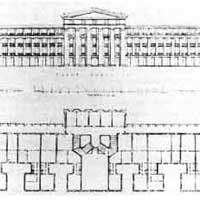Simutopia
Michael O'Malley, Associate Professor of History and Art History, and Paula Petrik, Professor of History and Art History, George Mason University
Introduction
The Jacksonian period (1828-1850) was an era of intense experiment and reform. Americans modified their laws, their institutions, and their morals according to new theories of social organization. The era saw the first appearance of a women's rights movement, the growth of abolitionism as a political force, and movements to restrict drinking and sexual behavior. As society was rapidly transformed by industry, Americans grew fascinated with the idea of planned communities—utopian societies which would ideally solve the major human problems of the day.
There were more than more than 130 attempts to establish utopian societies in the United States during the nineteenth century. They ranged from commercial ventures like "Hygeia" to religious utopias, to socialist collectives, all of which preached wildy different ideas. "We are all a little wild here with numerous projects of social reform," Emerson wrote to a friend in England. "Not a reading man but has a draft of a new community in his waistcoat pocket." Some of these experiments were extremely radical by any standard.
Within a few hundred miles of each other in western New York state, for example, two vastly different socialist/religious communities flourished: The Shakers and the Oneida collective.
Founded by Anne Lees, an immigrant mill worker, the Shakers practiced complete celibacy—men and women were strictly segregated. They believed that sexual relations were a sin, and that indeed God would bring about the end of the world by converting all men and women to the Shaker faith, after which no more children would be born. They lived in graceful simplicity and order, but also stressed machinery and human invention. Shaker communities invented the clothespin, the flatbroom, the circular saw, and several other labor and time saving inventions. Shaker furniture, produced by craftspeople working in teams, is highly prized today, and there are dozens of websites devoted to "Shaker Style" furniture. For more information see this link. At their height, the Shakers had about six thousand members.
The Oneida Collective, on the other hand, practiced what they called "complex marriage." All members of the collective were "married" to each other: all could have sexual relations with each other, but only at the woman's request. The Oneida community were "perfectionists:" they believed it was possible for human beings to attain moral perfection on earth. Only men who were deemed morally "perfect" could father children. Oneida was also highly successful, famous for its metal works and for its model schools. This link gives more information about Oneida, which disbanded as a community in 1879 and became what is now the Oneida Corporation. The corporate website tells little about the group's interesting past.
Updated | April 2004
